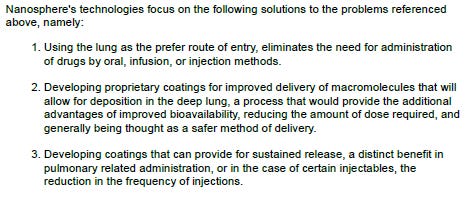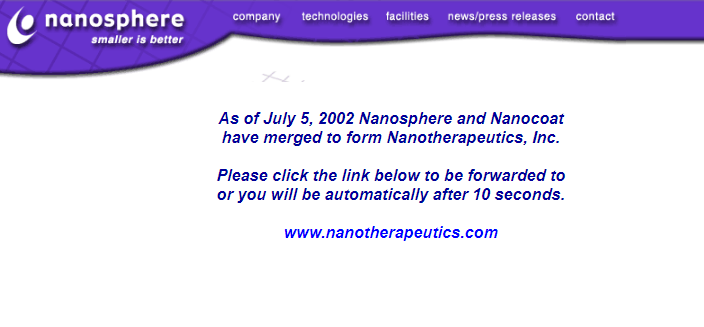Peering into the Nanocosm
How one tiny company helps us pull back the curtain on the global vaccine machine
One of the greatest delights that a naturally inquisitive person can encounter is the serendipitous arrival at the same logical endpoint as another explorer. The feeling is a bit like being lost in the woods until the moment you suddenly stumble upon someone else headed in the same direction as you. Apart from the comfort of having another human being at your side, there is a certain degree of confidence that comes with knowing that, while both of you may be lost, you were both walking in the same direction before you crossed paths.
This was pretty much the feeling I had recently when I stumbled on an article by the very talented Whitney Webb at her Unlimited Hangout. That article was about the newly formed National Resilience, Inc. which has ties to US intelligence and is involved with manufacturing mRNA components for the Moderna covid-19 vaccines.
You see, Whitney had followed a totally different path to the same company than the one I am about to describe. I think this is an important point to contemplate as we move through the strange history of Nanotherapeutics, Inc.
[note: All of the material I will be covering is conveniently summarized as a graphical timeline at the end of this article.]
[note: If you do not care for all of the particulars, you really must read the section titled “Deployment Era”]
Humble beginnings
Shortly after receiving a PhD in Pharmaceutical Sciences from the University of Florida (“Pulmonary Targeting of Inhaled Glucocorticoid Dry Powders”) in 1999, James Talton founded a company called Nanocoat Technologies, Inc. at the Sid Martin Institute in Alachua, FL. According to its website at the time, the focus of the company was to produce nanoparticles coated with biocompatible polymers to facilitate delivery of drugs into the lung.

A few months after founding Nanocoat Technologies, Inc., Dr. Talton incorporated a second company called Nanosphere, Inc. and then a third company called Nanobreath Technologies, Inc. in 2000. Nanosphere, Inc. acted as the primary company while Nanocoat and Nanobreath Technologies operated as subsidiaries. The main focus of Nanosphere, Inc. was stated as follows:

I think it is fairly clear from the above that the primary goal of Nanosphere, Inc. was to develop and market the technologies required for delivering biologically active agents deep into the lung.
Nanosphere, Inc. and Nanocoat Technologies, Inc. merged in 2002 to form Nanotherapeutics, Inc. Henceforth, I will refer to the company as Nanotherapeutics unless there is a specific reason for me to do otherwise.

The Product Development Era: 2000-2012
GlaxoSmithKline Investment
One of the earliest investors in Nanotherapeutics was GlaxoSmithKline (GSK), as mentioned here. Unfortunately, apart from this snippet I have not been able to find any additional specifics on the extent of GSK’s involvement with the company. However, it is worth considering that several former employees of GSK, some of them very high-level, sat on the advisory board of Nanotherapeutics. Here’s one example:

It is also worth pointing out the fact that GSK was the only pharmaceutical company to ever sponsor a non-human primate (NHP) challenge study using SARS-CoV in 2004.1 The location of the BSL-3 laboratory used for this study was not disclosed. The main point I want to make here is that GSK clearly had an interest in SARS-CoV around the time that they were getting fairly involved with Nanotherapeutics.
NIAID Research Projects and Grants
NIAID funded several Small Business Innovation Research (SBIR) projects at Nanotherapeutics between 2000 and 2012 which can be found using the NIH Reporter database. It was very curious to me that the very first project, titled “Dry Powder Coatings for Improved Tuberculosis Therapies”, was issued to Nanotherapeutics in spite of the fact that the company would not officially change its name from Nanosphere until 2002.
One long-running project titled “Nanoparticle Probe Assay for Biological Threats” was initiated in 2002 and ran through 2005. The goal of this project was to produce a rapid and reliable assay for detecting pathogens without requiring PCR or signal-based amplification.
In 2005, NIAID started another research project with Nanotherapeutics entitled “Inhaled Aminoglycoside Formula for Plague and Tularemia”.
After 2005, almost all of the NIAID funding to Nanotherapeutics came in the form of research contracts (activity code N01), with one important exception. In 2011, NIAID initiated a multi-year research project entitled “GelVac Stable, Dry-Powder Nasal Recombinant VLP-Based Bivalent Norovirus Vaccine”. GelVac is a patented vaccine delivery technology developed by Nanotherapeutics which relies on polymer-encapsulated antigen/adjuvant which can be stably stored as a dry powder until use. Once taken into the body by various routes, including inhalation, the powder becomes activated and provides a sustained release of antigen/adjuvant. Honestly, this sounds really creepy to me.
NIAID Research Contracts
A research contract (HHSN266200500046P) was issued to Nanotherapeutics (listed as Nanosphere, Inc. in the contract) in 2005 in the amount of $776K for the purpose of developing radiation countermeasures. A press release from NIAID on Oct. 12, 2005 confirmed the contract award and stated that there was a renewal option after 14 months. It appears that the contract was indeed renewed in the amount of $819K in late 2005. After that, there was activity on the contract in 2007 when a Change Order was issued in the amount of $499K. No description of the change was provided. Furthermore, this contract activity does not appear in NIH Reporter. Finally, in 2008 additional work was added in the amount of $949K, which does appear in NIH Reporter (N01AI50046-10-0-1).
A large contract was issued to Nanotherapeutics in 2008 for the development of inhaled gentamicin for the prophylaxis and treatment of aerosolized pneumonic plague and tularemia. Interestingly, while FPDS shows Nanotherapeutics receiving $9M for this project in 2008 (HHSN272200700030C), NIH Reporter only shows it receiving $1M (27220070030C-1-0-1). Another very interesting fact about this contract is that Nanotherapeutics collaborated with Lovelace Respiratory Research Institute (LRRI) in Albuquerque, NM, which I have written about extensively in previous articles.
Finally, in 2010 NIAID issued another contract to Nanotherapeutics for development of inhaled smallpox therapeutics. This contract paid out $6.4M and is listed in both FPDS and NIH Reporter.
DoD Medical Research Contracts
The DoD contracts to Nanotherapeutics are the ones I’m most interested in, but alas, there are really no details to be found at this time. There was one contract issued by the Department of the Army Medical Research Branch in 2005 for the amount of $70K (W81XWH05C0062) and another for $970K in 2010 (W81XWH10C0245).
Chairman of the Board
In 2008, a man named Weaver Gaines was appointed as Chairman of the Board of Nanotherapeutics. Strangely, among other things he was a senior advisor to the Bush/Quayle ‘92 campaign:

Apparently, this was a man with connections. I imagine they came in handy during his tenure.
The Deployment Era: 2012-2022
This is where things start to get really interesting. Starting around 2012-2013 there was a clear shift in the direction of Nanotherapeutics. Mostly, this seemed to be due to a very large contract from DoD in 2013 for the amount of $360M including all options. The initial amount awarded was $136M.
This contract was part of DoD’s Medical Countermeasures Advanced Development and Manufacturing (MCM-ADM) program. Ostensibly, the main purpose was to fund the construction of a manufacturing facility for medical countermeasures that would help to reduce the overall amount of time and cost associated with responding to emerging infectious diseases. Nanotherapeutics did construct a state-of-the-art manufacturing facility at its headquarters in Alachua, FL which opened in 2015.
But, that wasn’t the end of the story - not even close.
How to Launder a Multi-Million Dollar Vaccine Manufacturing Facility
In late 2014, Nanotherapeutics announced that they had purchased Baxter’s Vero cell vaccines platform as Baxter was looking to divest from its vaccine business and had recently sold most of its assets to Pfizer. What they failed to mention in their press release was that part of the deal was a vaccine manufacturing facility in Bohumil, Czech Republic. This acquisition was almost certainly funded in part or in full by the DoD contract to Nanotherapeutics.
About a year later, an interesting man named Peter Khoury joined Nanotherapeutics as Senior Vice President. Within a year he had been promoted to CEO. Here is some background on Dr. Khoury that you may find interesting:
Yep, it turns out that Peter Khoury previously worked for both the Bill and Melinda Gates Foundation and Baxter. As Vice President of Global Marketing at Baxter, I wouldn’t be surprised if he was the primary person responsible for arranging the sell of the vaccine facility in Bohumil to Nanotherapeutics.
Another crazy thing - I had the hardest time finding Khoury’s bio on the Wayback Machine. Prior to the name change to Ology Bioservices in 2017, Nanotherapeutics revamped their website to remove the News section and the About Us section was reduced to a simple boilerplate message without any substantive information about who was leading the company. After the name change to Ology Bioservices, there seems to be an issue with using the Wayback Machine with Microsoft Edge as it kept redirecting me to the National Resilience website. I just tried it again and it worked in Edge, so I’m not sure what to make of that. I even copied and pasted the same HTTP address between Edge and Brave. I got the Ology website using Brave and National Resilience using Edge. Strange. Try it yourself if you want here.
So, shortly after acquiring the Bohumil facility, Nanotherapeutics sold it to the Cyrus Poonawalla Group at the Serum Institute of India Pvt. Ltd. who used it to manufacture inactivated polio vaccines. Of note, the Gates Foundation donated $17M to the Serum Institute of India between 2012 and 2019.
A few months after the Bohumil sale, Nanotherapeutics changed its name to Ology Bioservices.
In 2020, Novavax acquired the Bohumil facility from Serum Institute of India and right after that it received a contract from DoD for covid-19 vaccines.
We’ve gone full circle through the process of laundering a vaccine manufacturing facility from the DoD to the DoD, with the Gates Foundation acting as a middleman.
Other Notable Events
Name change to Resilience
In April, 2021, National Resilience acquired Ology Bioservices. This is where we meet up with Whitney Webb’s reporting that I mentioned at the beginning of this article.
Robert Malone
In 2016, Robert Malone formed a Zika Response Working Group that published a paper on the response to the Zika virus2. This paper featured James Talton and Ronald Cobb of Nanotherapeutics. I only present this fact since Dr. Malone is such a well-known figure. I am not attempting to claim that he has any further involvement with anything else I have presented in this article.
Summary
I have a strong suspicion that NIAID, DoD and possibly GSK (others) collaborated between 2003 and 2010 to develop airborne models of infection for SARS-CoV and evaluated aerosolized nanoparticle therapeutics/vaccines, possibly for dual-use purposes - especially given the fact that so much of the work is shrouded in darkness. My previous articles provide a good background on the work performed at LRRI and how it may fit into the overall program. I’ll be writing more on this in the future.
As for the vaccine manufacturing facility in Bohumil, well, I’m still trying to pick my jaw up off the floor. This should be a big story. Please share.
Rowe, T. et al. Macaque Model for Severe Acute Respiratory Syndrome. 2004.
Malone, R.W. et al. Zika Virus: Medical Countermeasure Development Challenges. 2016.




https://www.medicalcountermeasures.gov/app/barda/COVIDTimeline.aspx#event-bardaacovid-19aresponseatimeline search for 'Novavax'
How do you think does BARDA fit into all of this?